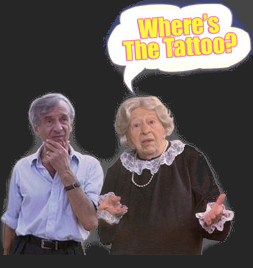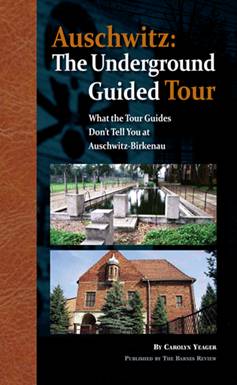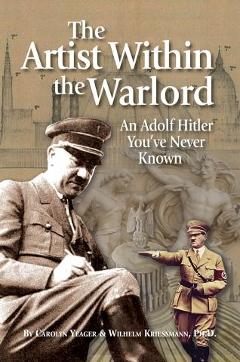The Anschluss of Austria
This report comes from a family chronicle that describes events during the so-called "Nazi era" as we experienced it. It is a testimony to great idealism and sacrifice for an Idea which filled us then. Today, most people see things in a very different light ...
The great hope: the German Reich
By Willy Wenger
copyright 2013 Wilhelm Wenger and Carolyn Yeager
Translated from the German by Hasso Castrup
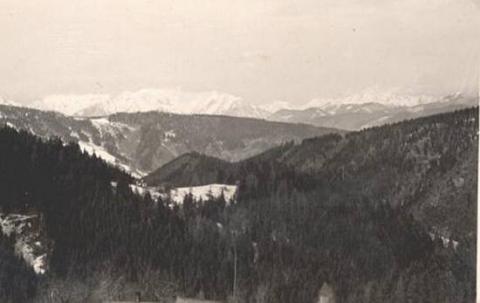
Eisenerzer Alps, January 1938
We got through the winter of 1937 well. We often traveled to our skiing places. I was usually in the company of my schoolmates; Mandi Holzer was always there. Poldi [Willy's older brother Leopold whom he called Bibi-cy] preferred the higher regions of Vordernberg auf den Polster (a popular ski resort, easy to reach from Leoben).
At the tender age of 12 there is a lot one doesn’t understand, but it still always aroused our interest when older students gathered during breaks at school and discussed the situation at that time. Again and again we were talking about Germany, for us a promised land flowing with milk and honey. While in Austria we still had a very modest standard of living, it seemed to go better and better in Germany. And that was thanks to one man: Adolf Hitler. One spoke of him as a god, who had pulled Germany out of the sump after the shameful Treaty of Versailles. Gradually Hitler brought back former German territories. And all this without bloodshed. It actually seemed as if there really was to be "no more war!"
Again and again the question was raised whether Austria was actually able to exist independently. And, increasingly, one doubted that and wanted to join the German Reich. The system which Germany applied was convincing. People wanted to be able to express their German nationalism and saw in Hitler's strong personality the ability to resolve all grievances and restore order. Many communities of nationally-minded Germans soon formed. People met secretly and joined the Nazi party, which was strictly forbidden in Austria.
Hitler was able to attain control over the citizenship. Within the ranks of NSDAP all interest groups were working together. Even before the takeover of power he created a group of followers who smoothed the way during numerous speeches: the storm troopers, known as SA. Later, a separate Protection Squad, the SS, was created. The workers were united in the DAF. Automobile and, above all, motorcycle owners were united in the NSKK. Those interested in aviation could join NSFK (Flying Corps). Particular emphasis was put on the youth. The boys from 10 years of age belonged to “Jungvolk,” the so-called “Pimpfe,” and the 14 to 18 year-olds were members of the “Hitler Youth” (Hitler Jugend - HJ). It was similar among the girls - they were all members of the League of German Girls, the BDM. There were a number of well-organized units in many spheres of life, like the TN (Technical Emergency) – a kind of fire squads, ready for disaster assistance. The political work was in the hands of political leaders who were in charge of local and regional groups. And, not least, the German women were organized in the National-Socialist Women (NS-Frauenschaft). This allowed the whole system to be well-controlled and guided. In Austria, many such organizations had been founded throughout the years, but, as mentioned, they were illegal. Yet, the illegals met quite regularly. Poldi was a member of the illegal HJ. In 1937, fifteen years old, he bicycled on his own to a summer camp of the banned Hitler Youth at Turnersee in Carinthia. He then rode his bike all the way to Germany and met with like-minded people at the major political event of the new German Reich, the Nuremberg Party Rally (Reichsparteitag). In winter, he met regularly with his friends at a ski hut in Gollinggraben. While there, he always had a great time in the company of good comrades who, like himself, dreamed of Austria joining the German Reich. And that dream was soon to become reality.
* * *
We were surprised at the news that the Austrian Chancellor Kurt Schuschnigg met with German Chancellor Adolf Hitler at the Obersalzberg on February 12, 1938. It seemed that things were going in the right direction. This meeting was followed by a reorganization of the Austrian Government. Dr. Arthur Seyss-Inquart as a representative of National-Socialists became Minister of Interior and Security Forces, and the military historian Dr. Glaise-Horstenau was appointed as minister without portfolio. Soon, there was a total amnesty. Many political prisoners were released from the district prisons, but also from the notorious prison camps Wöllersdorf and Messendorf.
In the ensuing days, our mountain town of Leoben was adorned with flags. When the Führer's speech was being transmitted by loudspeakers at the main square, the whole population of Leoben assembled there for the three hours the speech lasted. Afterwards, the enthusiastic crowds flocked to a mass rally where about 7000 people gathered. At night there was a huge torchlight procession.
In the following days, there were repeated major rallies which usually ended with further torchlight processions. On the other side, the Patriotic Front (Vaterländisches Front) called for rallies and protest marches, but these were followed by very few. When Schuschnigg saw no way out, he tried to save the sinking ship by setting up a referendum, scheduled for March 13th. His saying in the Tyrol was "Men, it is time!" (Männer, es isch Zeit!)
The situation deteriorated very quickly in Austria and especially in Styria. Graz [Styria's capital] resembled a military camp, and all this looked very dangerous. Machine guns were brought in position against a determined crowd. Very easily might an ill-considered action lead to terrible consequences.
Great tension prevailed in Leoben during these days. From Vienna, the Fatherland Front sent trucks with communists. They raced through the streets with raised fists and threw leaflets which no one gathered any more. After a report leaked out about postponement of the referendum, which was later confirmed by the radio – first timidly, but then in the windows of many houses swastika flags appeared. And if they were not everywhere, this was due to the fact that it was impossible to get sufficient material. Everybody was now in motion, and hurried into the inner city, greeted each other with the German salute. People took to chanting the words: "One people, one Reich, one Führer!" Strangers embraced; there was a jubilant mood and an outbreak of enthusiasm at the the Town Hall as the swastika flag was hoisted there.
Music blared the rousing old Austrian regiment marches and in the evening there rang from a thousand throats the German national anthem and the Horst Wessel Lied. Great was the enthusiasm, but also inner satisfaction of the people when the members of the gendarmerie and the police shared security duties with the SA and SS – all wearing swastika armbands.
Breathless with excitement, we all heard on the radio a proclamation of Dr. Joseph Goebbels announcing the entry of German troops in our country. Also on the radio we heard the solemn declaration by Seyss-Inquart – now the new and last chancellor – that Article 88 of the Paris Peace Treaty was now ineffective and that Austria wished to join the German Reich.
For us boys, a jubilant celebration; one could expect at least a few days off school! First, however, we awaited with extreme tension the coming of German troops. It gave me the same feeling that I always had on Christmas Eve: "Waiting." Yes, such a day would pass away that easy. We were clearly disappointed when at lunch no German troops were yet to be seen. All the more excited were we when a whole series of German planes roared rather low over our city. With a hell of a noise they flew through the narrow Mur Valley (Murtal) and landed, as we learned later, at the airport in Graz Thalerhof.
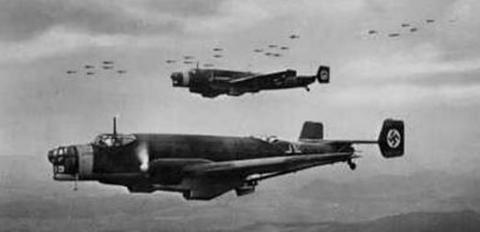
A group of German JU 86 bombers preparing for landing in Graz Thalerhof
Throughout the day we waited with high anticipation for the reports on the radio and watched out for the coming of the troops. The expected German soldiers seemed to take their time and only late in the evening the first troops arrived. For us young boys it was a huge disappointment when we found out that these were not soldiers but German police units. For us they were traffic police with their well-known Schupo-shakos [police helmets].
We kept waiting until the early hours of the morning, disappointed like most people at that time. Many women came with flowers to greet the marching soldiers, but they waited in vain. The next day, March 13th, when we woke up, many police units had already arrived. There was great jubilation and, in our enthusiasm, we practically attacked the cars of those officers who greeted us just as friendly. We were allowed to climb on the cars and all had only one goal – to put such a shako on – and we did it then much to the delight and fun of the German policemen. The Austrian police were still in the Austrian uniforms, but already had the swastika armbands and they shook hands cordially with their German colleagues.
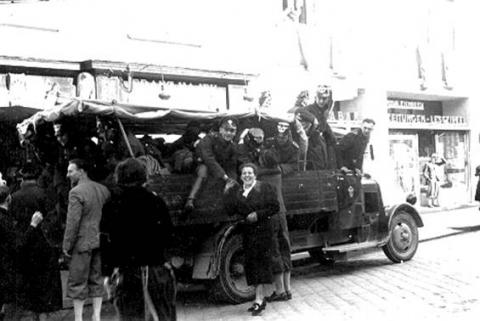
German Police were the first troops to come to Leoben
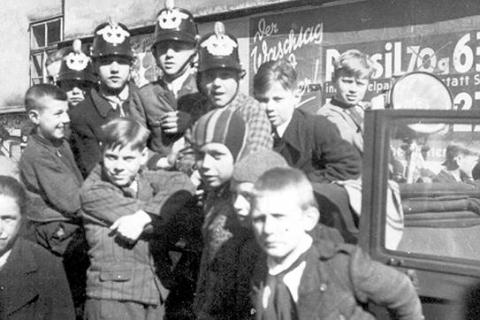
Willy's schoolfriends were allowed in police vehicle wearing "shakos"
These days, the melting water rose to such levels in the Mur, that there were several floods and the Wasen bridge and the wooden bridge in Judendorf were threatened.
Our enthusiasm had no limits. We felt very happy – we were free! All this we owed to one man, "the Führer." And we believed with conviction in this exemplary figure. The newspapers were full of Hitler's sayings, pictures were everywhere – on the streets, in the shops. The Führer was everywhere. And we loved and trusted him. It could even be said – "blindly."
We young boys waited longingly for the moment when we should get the, for us, so impressive uniforms. We had only recently become Jungvolk and were called "Pimpfe." (Much later I learned that the word "Pimpf" originates from pumpernickel.) This was because we wore the black velvet pants, a black scarf, like a tie, drawn together at the neck with a leather-knot and also a wide black leather belt with a plaque and the symbol of “Pimpfe” on it. But our pride was the hunting knife, which was worn like a bayonet on the side. And the head was adorned with a black cap, also provided with the HJ badge in front. Yes, and like all Nazi organizations we wore an armband with the swastika. We had to wait and watch jealously as others got those desired uniforms before us.
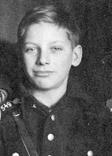
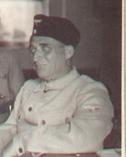
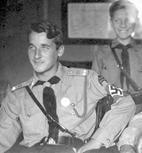
The three Wenger men in uniform. I as a “Pimpf.” Dad as a Technical Emergency man. Poldi as Gefolgschaftsführer [cadre unit leader] of the Hitler Youth.
Category
Adolf Hitler, Germany, National Socialism- Printer-friendly version
- 6988 reads






